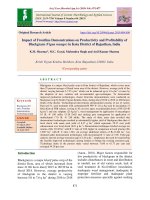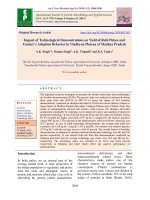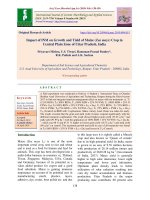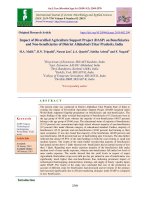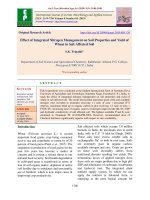Impact of integrated fish farming on antimicrobial resistant bacteria in pond environments in Osun state, Nigeria
Bạn đang xem bản rút gọn của tài liệu. Xem và tải ngay bản đầy đủ của tài liệu tại đây (242.12 KB, 8 trang )
Int.J.Curr.Microbiol.App.Sci (2019) 8(9): 2427-2434
International Journal of Current Microbiology and Applied Sciences
ISSN: 2319-7706 Volume 8 Number 09 (2019)
Journal homepage:
Original Research Article
/>
Impact of Integrated Fish Farming on Antimicrobial Resistant Bacteria in
Pond Environments in Osun State, Nigeria
Bolaji A. Samuel, Magdalene C. Igboama* and I.I. Olufade
Department of Science Laboratory Technology, Federal Polytechnic Ede, Osun State, Nigeria
*Corresponding author
ABSTRACT
Keywords
Integrated, Fish
Farming,
Antimicrobial
Resistant, Impact,
Bacteria
Article Info
Accepted:
24 August 2019
Available Online:
10 September 2019
The use of antimicrobial agents in integrated fish farms poses public health problem in a
developing country like Nigeria. Materials used in this study were integrated fish farm,
imported fish feed, pond water and fish guts respectively. Different bacteria were isolated
from each material above and each isolate was characterized. Antibiotic susceptibility test
was carried out on each isolate using commercially available antibiotic disks respectively.
A total of 48 bacteria were isolated from the four samples. Pond water sample and pond
sediment had a total of 14 (29.2%) bacteria isolates from Ringroad, Sawmill and Mobi
respectively. Fish guts had a total of 11 (22.9%) of bacteria isolates from the three samples
used. Lastly, 9 (18.7%) bacteria were isolated from the fish feed used in this study. Eleven
species were isolated from the four specimen types. Escherichia coli occurs 7 (14.5%) in
the four specimens while Aeromonas species, Salmonella species and Morganella morgani
occur 5 (10.41%) in all the four sample types. Also, Proteus species, Enterobacter sp,
Klebsiella sp and Serratia occur in all the four samples 4 (8.33%) while Provindencia sp.
and Shigella sp occur 3 (6.25%) and 2 (4.16%) respectively. The result of antimicrobial
susceptibility test by disk diffusion showed that Septrin (93%) and Chloramphericol (93%)
had the highest resistance to all the bacteria isolates. This is followed by antibiotic
resistance of Augumentin (67%) and Amoxacilllin (53%) respectively. However, this
shows that there is need to evaluate the prevalence of antimicrobial resistant bacteria in
integrated fish ponds in order to prevent and control the development of antibiotic resistant
bacteria in pond environment.
Introduction
Integrated fish farming is a system of farming
that combines livestock production with fish
farming. The system utilizes animal excreta,
urine and feed leftovers as pond substrates to
enhance the growth of plankton and other
microorganisms eaten by fish. In integrated
fish farms, animal dung is shed into the fish
pond as manure supporting the growth of
plankton and other micro organisms eaten by
fish thereby producing high yields of fish with
low input as the fish receive limited
supplementary feed. The livestock on the
other hand are fed with feed containing
antimicrobial agents which serve as growth
promoters. It has the capacity of meeting up
with fish demand as it supplies enough
manure to produce large quantity of fish
(Ayinla 2003). Integrated fish farming
2427
Int.J.Curr.Microbiol.App.Sci (2019) 8(9): 2427-2434
provides job opportunities to both the women
and the teeming population of the youths in a
country. In addition to the above, the system
provides food security and raises nutritional
status by providing important complementary
ingredients for better nutrition.
Materials and Methods
The combination of fish and poultry or fish
and piggery excreta have been found to
fertilize the pond and are avenue for fish to
derive their energy. The use of poultry in
integrated fish farming has been found to be
beneficial to the fishes because of the algal
bloom produced which serves as food and
hiding place for fishes (FAO, 2003). Pig and
fish combination on the other hand increases
both economic and ecological efficacy as
aquatic plants, wastes, residues and left over
from kitchen are used as Pig food while the
excreta of the Pigs which is very rich in
nutrients is used as organic manure and fish
feed in ponds thereby greatly reducing the cost
of fish production (AIFP. 2005).
Integrated fish farms located at Mopo Ede,
Mobi Ede and Ring road Osogbo, Osun state,
Nigeria were accessed in this study after
consent was obtained from the owners.
Information on the type of feed given to the
fish and livestock was obtained verbally from
the managers of the ponds.
All materials including media, glass wares and
bench surfaces were adequately sterilized.
Study area
Collection of samples
A total number of four specimens from each
farm site were collected. The samples were;
Pond sediments, Pond water, Fish feeds ad
Fish gut. The samples were transported to the
laboratory for immediate analysis.
Isolation of bacteria
The feed of the livestock mainly chickens and
pigs contain antibiotics which are used for
therapeutic or prophylactic purposes in
integrated fish farms, These antimicrobial
agents serve as growth promoters to fishes and
prevent proliferation of bacteria in fish pond
however
bacteria
that
survive
the
antimicrobial agents become drug resistant
serving as reservoirs of resistant genes from
which genes can be disseminated to human
pathogens (Ole et al., 2009). These antibiotic
resistant bacteria (ARB) may be harbored on
the skin, gut and slime of living fish which if
consumed may cause infections in humans and
result in treatment failures.
Information on the development of
antimicrobial resistant strains of bacteria in
fish ponds in Osun state, Nigeria is scarce
hence the need for this study which is
designed to investigate the impact of
integrated fish farming on antimicrobial
resistant bacteria in a pond environment.
One gram of Pond sediments, Pond water,
Fish feeds and Fish guts was accurately
weighed out, ground and serially diluted. One
milliliter of the aliquots from the dilution 10-5
of each sample was transferred into
appropriately labeled petri dishes into which
sterile MacConkey agar was poured and
allowed to solidify. This was done in
triplicates (Harley and Precott, 1996). The
plates were incubated at 37ºC for 24 hours
after which developed colonies were counted
to obtain total viable count followed by sub
culturing. Pure cultures were stored at 4ºC in
slants of MacConkey agar.
Characterization
bacteria isolates
and
identification
of
The isolates were characterized and identified
based on their cultural characteristics, grams
stain and biochemical reactions.
2428
Int.J.Curr.Microbiol.App.Sci (2019) 8(9): 2427-2434
Antibiotic susceptibility test
The bacteria isolates were examined for
susceptibility to commonly used antimicrobial
agents using commercially available discs and
following the manufacturers’ instruction. The
zones of inhibition were read after incubation
and recorded as resistant or sensitive.
Results and Discussion
The average plate counts of samples from
different location were significantly different
as P < 0.05 for each of the locations. The
bacterial count in Sawmill pond ranged from
5.0 x 106 Cfu/ml to 1.40 x 107 Cful/ml. Also,
in Mobi pond the bacteria counts ranged from
9.5 x 106 Cfu/ml to 2.92 x 107 Cfu/ml while
the bacteria counts in Ring road had 9.1 x 106
Cfu/ml to 2.27 x 107 Cfu/ml respectively.
Pond sediments and water samples from Mobi
pond had the highest bacterial counts and this
was followed by those from fish pond water of
Ring road and Sawmill respectively. The
highest bacterial count was also recorded in
Fish gut sample obtained from Sawmill pond
water and this was followed by the higher
bacterial count in Mobi and Ring road pond
water respectively. Similarly, the highest
bacterial count was recorded in Ring road
pond followed by the least bacterial count in
Mobi and Sawmill respectively (table 1).
A total of 48 bacteria isolates were gotten
from four specimen types; Pond water, Pond
sediment, Fish feed and Fish gut. Bacterial
isolates identified were: Escherichia coli
7(14.58%), Aeromonas species 5(10.41%),
Salmonella species 5(10.41%), Proteus
species 4(8.33%), Citrobacter freundii
3(6.25%), Morganella morganii 5(10.41%),
Enterobacter species 4(8.33%), Serratia
species 4(8.33), Klebsiella species 4(8.33%),
Provindencia species 3(6.25%) and Shigella
species 2(4.16) (Table 3).
Escherichia coli, Aeromonas species and
Serratia species, were the bacteria that
occurred in all the four samples (Table 3). The
bacteria isolates that occurred both in pond
water and pond sediment were: Citrobacter
freundii and Proteus species while only
Shigella species were isolated from both fish
gut and fish feed (Table 3).
Pond water had a total of 14 (29.2%) bacteria
isolates of which 4 (8.33%) were from Ring
road, 8(16.66%) bacteria isolates were from
Mobi pond while 2(4.17%) bacteria isolates
were from Sawmill pond at the lowest
proportion. Water sediment had a total of
14(29.2%) bacteria isolates of which
2(4.16%), 9(18.7%) and 3(6.25%) were from
Ring road, Mobi and Sawmill ponds
respectively. Fish gut had a total of 11(22.9%)
bacteria isolates of which 5(10.41%) and
3(6.25%) bacteria isolates were from Mobi,
Ring road and Sawmill ponds respectively.
A total of 9(18.7%) bacteria isolates were
reported for Fish feed out of which 2(4.16%)
bacteria isolates were from Ring road,
4(8.33%) from Mobi and 3(6.25%) from
Sawmill pond (Table 2).
The highest percentage of bacteria was
observed to occur in water sediment sample.
This could be as a result of accumulation of
surplus feed overtime. Pond water sample was
observed to be next in bacteria percentage.
This could be because feed was applied to
water over a period of time. Gut and feed
samples had the lowest percentage of bacteria
isolates. The reason could be because there
was no accumulated effect in feeds and the
feed which the fish ate had been mixed with
water before entering the gut of the fish
(Figure 1).
The result of the Antimicrobial Resistivity
Test revealed that most of the isolated
organisms were resistant to multiple
2429
Int.J.Curr.Microbiol.App.Sci (2019) 8(9): 2427-2434
antibiotics.
The
highest
antimicrobial
resistance of 93.33% was exhibited against
Septrin and Chloramphenicol by 14 isolates
while this was followed by a higher
antimicrobial resistance of 66.67% against
Augumentin by 5 isolates. The lowest
antimicrobial resistance of 6.67% was
obtained for 1 isolate against Ciprofloxacin
(table 4).
Table.1 Average bacterial count of isolates from the samples
LOCATION
ERROR
CODE
EDE SAWMILL
MCA WITH STANDARD
ESS
8.2
ESW
5.0
ESF
1.35
20.82
EMS
2.92
5.13
EMW
1.81
18.01
EMF
9.5
EMG
1.00
ORS
2.27
ORW
1.46
ORF
1.60
ORG
9.1
20.43
ESG
EDE MOBI
OSOGBO RING ROAD
Key:
ESS –Ede Sawmill Sediment
ESF – Ede Sawmill Feed
ESW – Ede Sawmill Water
ESG – Ede Sawmill Gut
EMF – Ede Mobi Feed
EMW – Ede Mobi Water
EMS – Ede Mobi Sediment
EMG – Ede Mobi Gut
18.93
17.56
10.41
ORS – Osogbo Ringroad Sediment
ORG – Osogbo Ringroad Gut
ORW – Osogbo Ringroad Water
ORF – Osogbo Ringroad Feed
Table.2 Percentage bacteria in different locations
Location
Ring road
Mobi
Sawmill
Pond water
4(15.38%)
8(30.77%)
2(18.18%)
Water sediment
2(18.18%)
9(34.62%)
3(27.27%)
Fish gut
3(27.27%)
5(19.23%)
3(27.27%)
Fish feed
2(18.18%)
4(15.38%)
3(27.27%)
2430
Int.J.Curr.Microbiol.App.Sci (2019) 8(9): 2427-2434
Table.3 Bacteria distribution in each sample
ISOLATES
Escherichia coli
Aeromonas species
Salmonella species
Proteus species
Citrobacter freundii
Morganella morganii
Enterobacter species
Serratia species
Klebsiella species
Provindencia species
Shigella species
POND
WATER
FISH FEED
POND
SEDIMENT
FISH GUT
TOTAL
OCCURENCE IN
THE SAMPLES
1
1
1
2
2
2
1
1
2
1
-
2
1
2
1
1
1
1
1
1
2
2
1
2
1
1
2
1
-
3
2
2
1
1
2
7(14.58%)
5(10.41%)
5(10.41%)
4(8.33%)
3(6.25%)
5(10.41%)
4(8.33%)
4(8.33%)
5(10.42%)
3(6.25%)
3(6.25%)
Table.4 Percentage susceptibility pattern of bacteria to antibiotics
Antibiotics
SXT
CH
CPX
AM
AU
GN
PEF
OFX
S
SP
Key
SXT = Septrin
CPX = Ciprofloxacin
AU = Augmetin
PEF = Perfloxacin
S = Streptomycin
R = resistant
Sensitivity S (%)
1
(6.67%)
1
(6.67%)
14 (93.33%)
7 ( 46.67%)
5 ( 33.33%)
10 (66.67%)
10 (66.67%)
9 (60%)
8 (53.33)%
13 (86.67%)
CH = Chloramphenicol
AM = Amoxacilin
GN = Gentamycin
OFX = Tarivid
SP = Sparfloxacin
S = sensitive
2431
I
Resistivity R (%)
14
(93.33%)
14
(93.33%)
1
(6.67%)
8
(53.3%)
10
(66.67%)
5
(33.33%)
5
(33.33%)
6
(40%)
7
(46.67%)
2
(13.33)
Int.J.Curr.Microbiol.App.Sci (2019) 8(9): 2427-2434
Figure.1 Percentage (%) of bacteria isolates per location
40
35
30
25
20
sawmill
15
mobi
10
5
0
Pond water
Water sediment
Fish gut
The
isolation
of
Enterobacteriaceae:
Escherichia coli, Aeromonas species,
Salmonella
species,
Proteus
species,
Citrobacter freundii, Morganella morganii,
Enterobacter species, Serratia species,
Klebsiella species ,Provindencia species and
Shigella species from the three locations are
in line with the findings of Ogbondeminu and
Olayemi (1993) who reported that 50% of the
microorganisms recovered from both fish and
water of earthen pond fertilized with animal
faecal waste were members of the family
Enterobacteriaceae.
The presence of E. coli in all the samples
indicated poor hygiene and sanitary condition
in all the locations. This is in line with the
study of Chandraval et al., (2010) which
reported that fish and water samples collected
from Nadia District of West Bengal in India
were contaminated with faecal coliforms.
Aeromonas species, one of the bacteria
isolated from the samples is a known human
pathogen which poses a risk of fish-borne
Aeromonas gastroenteritis in consumers of
improperly cooked fish however this has
shown that consumption of antibiotic in fishes
Fish feed
has become a serious issue in various
environments for human health concern
(Neela et al., 2012; Rahman et al., 2008) and
it has been well demonstrated that aquatic
environments play a vital role for spreading of
antibiotic resistant bacteria and gene in
various ecosystem (Neela et al., 2009).
Surplus antimicrobial agents accumulate in
integrated fish farms when the ponds are
rarely emptied at the time of fish harvest, such
an accumulation has been reported to
establish selective pressure favoring selection
and growth of antimicrobial resistant bacteria
(Andreas et al., 2002). This may be the reason
why some of the bacteria isolates used for this
study were able to resist all the tested
antibiotics.
Potential transfer of resistant bacteria and
resistance gene from aquaculture environment
to human can occur through direct
consumption of antimicrobial resistant
bacteria present in fish and associated
products and this can lead to an increase in
the number of infections, an increased
frequency of treatment failure and increased
severity of infection (Andreas et al., 2002)
2432
Int.J.Curr.Microbiol.App.Sci (2019) 8(9): 2427-2434
Conclusion of the study is as follows:
In view of the isolation of potential bacterial
pathogens from all the sample types and high
level of multi drug resistant bacterial
contamination reported in this study necessary
measures must be put in place to prevent the
release or discharge of antimicrobial residues
and antimicrobial resistant bacteria into ponds
in Nigeria, particularly in Osun state in order
to prevent the transfer of resistant genes from
fish pathogens to human as the effect can be
devastating if consumed by man. Such
measures include: discouragement of the
indiscriminate use of antimicrobial agents in
integrated fish farms, discouragement of the
use of faeces of poultry and encouragement of
the use of feeds with high microbial quality in
order to avoid using antimicrobials as growth
additives. There should also be regular
drainage of pond water after specific period of
time. In addition to the above, there should
equally be public enlightenment programme
on the inherent danger that may accompany
the consumption of improperly cooked fish.
Lastly more elaborate studies especially
multicenter studies should be carried out to
determine the impact of Integrated Fish
Farming on Antimicrobial Resistant Bacteria
in ponds on a national level in order to enable
formulation of guidelines for monitoring and
establishing preventive programmes.
References
AIFP (2005): Farming in Nigeria waters.
Newsletter of the Aquaculture and
Inland Fisheries project of the National
Special Programme for food security in
Nigeria. FAO Office Abuja, Nigeria.3
(4): 2-4.55.
Andreas Petersen, Jens Strode Anderesen,
Tawatchal
Kacwmak
Temdoung
Somsin and Anders Dalsgaard (2002):
Impart of integrated fish farming on
2433
antimicrobial resistance in a pond
environment: Appl Environ microbial
Vol.68(12:6036-6042).
Ayinla, O.A. (2003): Integrated fish farming:
A
veritable
tool
for
poverty
alleviation/Hunger eradication in the
Niger Delta Region. In A.A Eyo and
J.O
Atanda
(eds).
Conference
Proceedings of Fisheries Society of
Nigeria, Owerri, Nigeria. Pp. 40-41.
Bager F.M.; Madsen J. Christensen and F.M.
Aarestrup (1997): Avoparcin used as a
growth promoter is associated with the
occurrence of vancomycin resistant
Enterococcu faecium in Danish poultry
and pig farm prev. vet. Med. 31 – 95 –
112 (pubmed).
Chandraval, D., Debasish, S., Ashis, K. P.
and Chandan, S. (2010). The occurrence
of scherichia coli in fish samples
isolated from different ponds of Nadia
District, West Bengal, India. Internet
Journal of Food Safety, 12:181-186.
Davies, (1997): Origins, acquisition and
dissemination of antibiotics resistance
determinants, Ciba F symp 207:15-27.
FAO, (2003): The Role of Aquaculture in
improving food Security and Nutrition.
Committee on World food Security,
food and Aquaculture Organization of
the United Nations, Romes.
Harley, J.P. and Prescott, L.M. (1996)
Microbiology Laboratory Exercises. 3rd
Edition, McGraw-Hill Companies, New
York.
Neela, F.A., Nonaka, L., Rahman, M.H &
Suzuki, S. (2009): Transfer of the
chromosomally encoded tetracycline
resistant gene tet(M) from marine
bacteria to Escherichia coli and
Enterococcus faecalis. World Journal of
Microbiology and Biotechnology 25(6):
1095-1101
Neela, F.A., Rahman, M.A., Banu, M.N.A.,
Rahman, M.H., OHTA, H. & Alam,
M.F. (2012): Occurrence of two
Int.J.Curr.Microbiol.App.Sci (2019) 8(9): 2427-2434
antibiotic resistant bacteria in aquatic
environment associated with shrimp
farming in Bangladesh. Bangladesh
Journal of Botany 41(@): 197-200.
Ogbondeminu
and
Olayemi
(1993).
Antibiotic resistance in enteric bacterial
isolates from fish and water media.
Journal of Aquatic Tropical, 8:207-212.
Ole E. H., Hilde K., KARI G., Collignon P.,
Iddya K, (2009): Human Health
Consequences of Use of Antimicrobial
Agents in Aquaculture. Clinical
Infectious Diseases 49: 1248-1253.
Rahman, M. H., Nonaks, L., Tago, R. &
Suzuki S. (2008): Occurrence of two
genotypes
of
tetracycline
(TC)
resistance gene tet(M) in the TCresistant bacteria in marine sediments of
Japan. Environmental Science and
Technology 42(14): 5055-5061.
Shashank Singh, Prabjeet Singh, Nitin Verma
and Diniesh Kumar (1991): Integrated
fish farming-Rationale and scope.
College of fisheries, G.B. Pant
University
of
Agriculture
and
Technology, Pantnagar, India.
How to cite this article:
Bolaji A. Samuel, Magdalene C. Igboama and Olufade, I.I. 2019. Impact of Integrated Fish
Farming on Antimicrobial Resistant Bacteria in Pond Environments in Osun State, Nigeria.
Int.J.Curr.Microbiol.App.Sci. 8(09): 2427-2434. doi: />
2434




